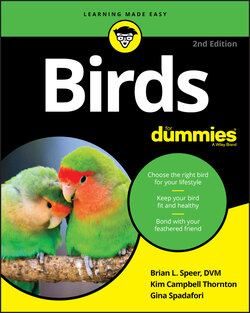Читать книгу Birds For Dummies - Gina Spadafori - Страница 75
After the age of sexual maturity
ОглавлениеBirds beyond the age of sexual maturity may be among the riskiest purchases you can make. Like people, grown-up birds are often set in their ways, and if their ways include some undesirable behaviors, you can expect to have a difficult time making any changes.
Adolescent birds often go through a bitey period. Other behaviors that emerge during this “teenage stage” include sexual behaviors, whistling, singing, talking, and territorial behavior — metaphorically placing a “Keep Out!” sign on the front door of the cage. Now is a good time to stock up on toys and other items that it’s okay for your bird to destroy. When their African ringneck, Larry, went through this phase, Kim and her husband went through dozens of pairs of wooden chopsticks acquired from Chinese restaurants and sushi bars. Larry loved reducing them to wood chips.
Some birds also become available because they’re sexually mature. Like human teenagers, birds can drive you crazy because hormones are driving them crazy. Some birds change from Jekyll to Hyde seemingly overnight, and people who don’t understand or know how to cope often give up their pets in frustration. Sometimes such birds pass from home to home to home, sold and sold again, becoming bigger problems at each stop. These birds are not necessarily good pet candidates; realistically, they’re rehabilitation projects at best and may be suited only for experienced bird keepers. These birds deserve a good home, but it needs to be the right home, with a loving and experienced owner.
With that word to the wise in mind, know that even among older birds, some real gems become available — birds with good manners and good health; loving, well-socialized birds who are fully capable of bonding with a new owner. Move with all due caution, but if you find such a bird, buy her. She’s a good deal and a good deed, all rolled into one.
As the popularity of pet birds continues to hold, so, too, does the number of birds given up by their owners. The typical dog- and cat-oriented animal shelter isn’t really equipped to accept and rehome birds (although some do, of course). A variety of groups now operate to fill the gap, serving solely to rescue, rehabilitate, and rehome pet birds. Some of these groups provide careful screening and extensive education of prospective owners to increase a bird’s chances of sticking in a new home. These organizations can be an excellent source of pet birds. To find one, talk to veterinarians, pet stores (especially those specializing in birds), and shelters in your area. We list a few in the appendix at the back of this book.
